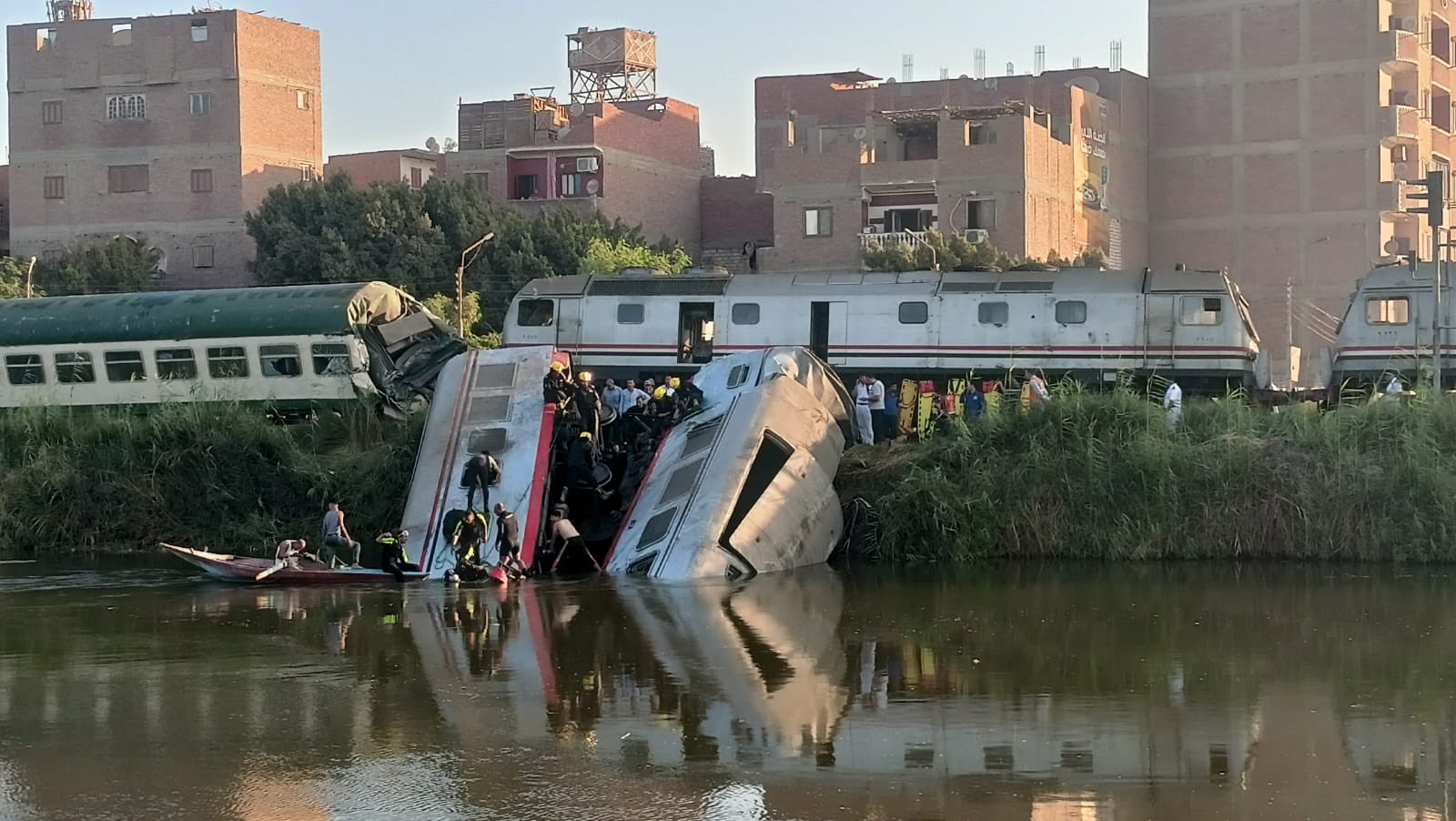Train Collision in Egypt
A tragic train accident struck southern Egypt on Sunday, October 8, 2024, when a locomotive collided with the rear of a Cairo-bound passenger train. The crash, which occurred in the Minya province, left one person dead and over 20 injured. This marks the second major train accident in Egypt within a month, raising concerns about the safety of the country’s ageing railway system.
Location and Details of the Train Collision
The collision occurred in Minya, a province approximately 270 kilometers (about 168 miles) south of Cairo. According to the Egyptian National Railways (ENR), the locomotive crashed into the back of a moving passenger train. The impact caused two carriages to derail and fall into a nearby canal, partially submerging them in the water. The cause of the accident is still under investigation.
Footage of the aftermath aired by local media showed the submerged carriages, sparking concern among the public regarding the condition of Egypt’s rail infrastructure. The images, widely circulated online, emphasized the severity of the accident and the immediate need for a railway overhaul.
Casualties and Injuries
As of the latest reports, at least one person has been confirmed dead. The Egyptian Ministry of Health issued a statement confirming that 21 passengers were transported to local hospitals. Most of the injuries were minor, and 19 individuals were discharged after receiving treatment, leaving two victims in hospital for further care. Emergency response teams arrived at the scene to assist the injured and recover the submerged carriages.
Recurring Train Crashes in Egypt
Unfortunately, train crashes and derailments are not uncommon in Egypt. The country’s railway system, one of the oldest in the region, has been plagued by years of underfunding, lack of maintenance, and mismanagement. This is the second major train collision in a month, following a crash in September in a Nile Delta city, which claimed three lives.
Egyptian railways have seen a disturbing number of accidents in recent years. One of the deadliest incidents occurred in 2002 when a train fire killed over 360 people. Since then, several other major accidents have drawn attention to the deteriorating state of the national rail network. In 2021, two passenger trains collided in the city of Sohag, killing 32 people and injuring over 100.
Investigations and Possible Causes
While the cause of this particular crash is still under investigation, Egypt’s railway authority has acknowledged a pattern of human error and outdated systems contributing to frequent accidents. In many cases, aging infrastructure, malfunctioning signals, and inadequate safety protocols have been blamed for accidents.
Investigators are expected to examine the mechanical condition of the trains involved, as well as the working conditions of railway staff. Some reports suggest that the locomotive’s driver might not have been alerted about the passenger train ahead, leading to the crash. Further details will be revealed as the investigation progresses.
Efforts to Revamp Egypt’s Railways
The latest incident has once again spotlighted the urgent need for reform in Egypt’s railway sector. President Abdel Fattah al-Sisi has acknowledged the issue in previous years. In 2018, the Egyptian government announced that it would allocate 250 billion Egyptian pounds (approximately $8.13 billion) to overhaul the country’s rail network.
Among the proposed improvements were the modernization of tracks, the introduction of advanced signaling systems, and the replacement of old carriages and locomotives. However, despite these efforts, accidents have persisted, raising questions about government plans’ effectiveness.
In response to public outcry, the Ministry of Transport has reaffirmed its commitment to improving safety and efficiency on Egypt’s railways. A portion of the allocated funds has been used to purchase new trains and upgrade railway crossings, but much of the network still relies on outdated infrastructure.
Public Outcry and Calls for Accountability
Each new railway disaster in Egypt is met with widespread public outrage. Citizens have taken to social media to express frustration over the lack of progress in improving train safety. Many blame government negligence and inefficiency for the continuous stream of accidents, demanding better oversight and stricter safety measures.
The fatalities and injuries caused by train collisions are not just tragic but also preventable, according to transport experts. Several railway safety organizations have urged the government to accelerate its efforts to modernize the system and to implement more rigorous training programs for railway staff. The Egyptian government has pledged to hold those responsible for such accidents accountable, but critics argue that more immediate and tangible results are needed.
Global Attention on Egypt’s Rail Safety
Egypt’s repeated train disasters have also drawn international attention. As the largest country in North Africa, Egypt’s transportation system plays a critical role in connecting its cities and supporting trade. However, the high frequency of rail accidents has prompted foreign investors and organizations to question the safety and reliability of its infrastructure.
International transportation experts have offered to collaborate with Egyptian authorities in implementing safety measures, including upgrading technological systems and enhancing staff training. The involvement of foreign partners could accelerate progress, but the financial burden remains a major hurdle for the Egyptian government.
Conclusion
The tragic train collision in Egypt’s Minya province, which led to the death of one person and injured 20 others, serves as a grim reminder of the country’s longstanding railway issues. Despite efforts to modernize the rail system, frequent accidents continue to occur, highlighting the need for urgent and comprehensive reforms.
The Egyptian government has made promises to invest in infrastructure improvements, but the recurrence of such tragedies has left many questioning whether enough is being done to protect passengers. As investigations into the cause of this latest accident continue, the nation waits for answers and hopes for meaningful change.








